Polished concrete: what it is, advantages and main uses
Almost all of us have heard about polished concrete at some point. It was one of the most used materials in the 20th century in industrial spaces and apartments, thanks to an aesthetic compatible with different decorative styles. Currently, it is one of the options we have at our disposal to transform the floor of the house.
But, before thinking about covering any surface, it is very clear what polished cement is and the advantages it offers. A material that is often confused with microcement, absolute conqueror, in recent years, of the decoration of both interior and exterior spaces, but that have great differences to take into account.
In this post we tell you everything about polished concrete and what it brings to the decoration. Keep reading and take note!
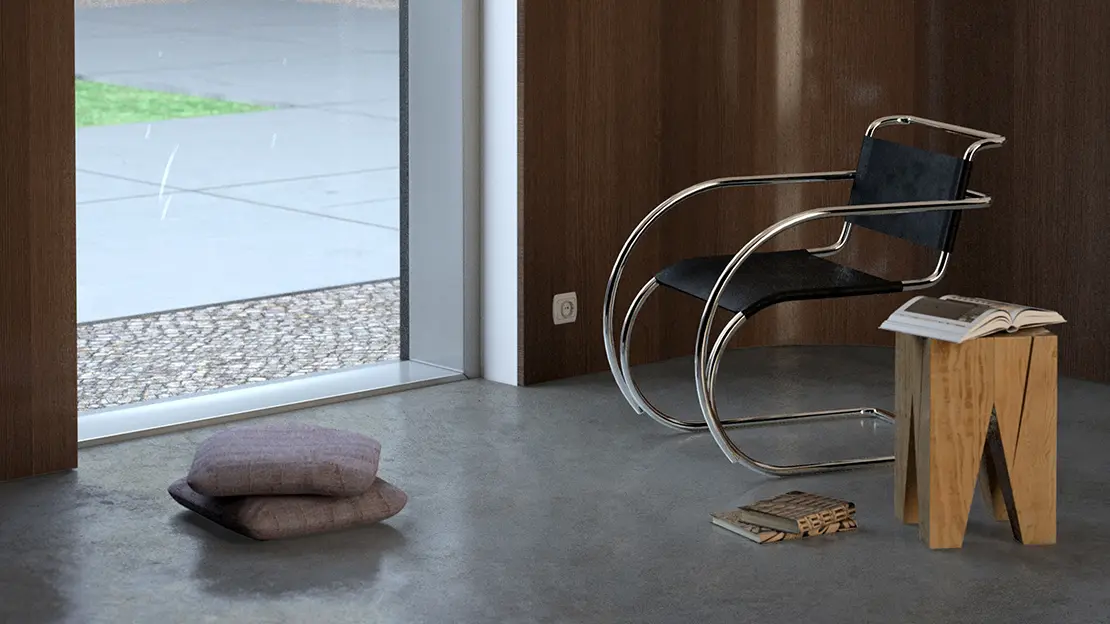
What is polished concrete? Industrial finishes for floors
Polished concrete is a material created from the mixture of aggregates, additives, water, and pigments. Specifically, it is a layer of refined cement to which a dye is added, which is then polished with a special machine. As a result of this process, a continuous pavement about 5 millimeters thick is created, perfect for coating interiors and exteriors.
As a decorative coating, it is applied directly to the floor creating a uniform and modern finish, becoming a great ally to achieve rooms where contemporaneity and avant-garde are breathed.
This material, whose application is exclusive to floors, was one of the first coatings used to cover the floor of commercial establishments such as factories, offices or premises. Years passed and these began to convert to the domestic sphere and they realized that floors coated with polished cement were a great option for daily life since, in addition to providing resistance and, in turn, transforming homes into more comfortable places, it also increased aesthetic performance.
The best of polished concrete: most outstanding advantages of applying it
Polished concrete is a paving technique that prioritizes functionality and durability over aesthetics. This technique is characterized by its remarkable resistance and durability, making it an ideal option for spaces that require high resistance to pedestrian traffic and daily use.
In addition to its durability and resistance, polished concrete has many other properties that make it a highly versatile and economical material. Below, we detail all the characteristics of polished concrete that make it an ideal option for any construction project.
Firstly, polished concrete is highly durable and resistant to pedestrian traffic and daily use. This material is very resistant to friction and wear, making it ideal for use in high traffic areas.
The process of polishing concrete involves removing the top layer of the surface, which eliminates any defects or imperfections and leaves a smooth and uniform surface. In addition, polished concrete does not scratch easily, making it ideal for use in high traffic areas.
Secondly, polished concrete is a versatile material that can be used both indoors and outdoors. It can be customized to fit any style of decoration by adding pigments and other materials to change its appearance and texture. In this way, polished concrete can adapt to any design, whether it is industrial, modern, rustic, classic or elegant.
Thirdly, polished concrete is easy to clean and maintain. It does not require costly maintenance or additional sealing. To keep the polished concrete clean, a damp cloth or mop can be used to remove dirt and dust.
A gentle cleaning solution can also be used to clean stains. In addition, polished cement is anti-static and does not attract dust, making it ideal for people with respiratory problems or allergies.
Lastly, polished concrete is a cost-effective option compared to other finishing materials. The process of polishing concrete does not require the installation of an additional coating layer, which saves time and money. Moreover, polished concrete is a durable material that does not require frequent replacement, which also reduces long-term costs.
Cons of coating floors with polished concrete
The choice of polished concrete is perfect for achieving an industrial atmosphere that evokes the large New York lofts that began to become so famous in the 90s, but it also presents a series of disadvantages as a coating.
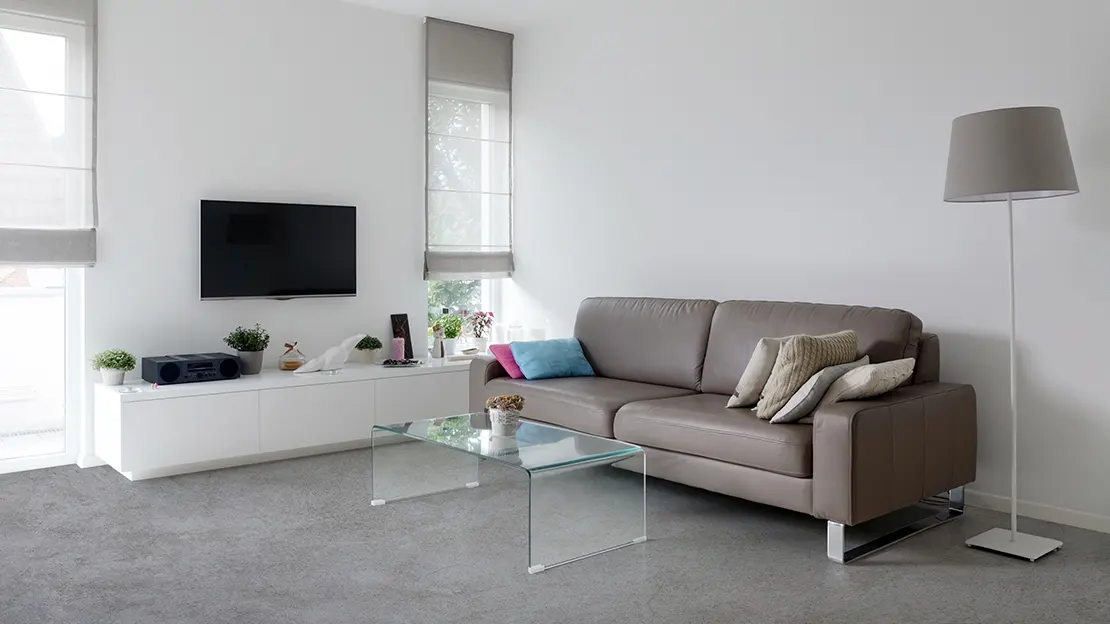
- Over time, polished concrete can lose its initial shine.
- Unlike other decorative coatings, it requires large polishing machines to achieve quality finishes. And, it should be noted, that this type of machinery, as a general rule, does not reach all corners.
- It is an inefficient material if we want it to act as a thermal and acoustic insulator.
- Liquids that are spilled on the surface should be dried before their absorption.
- It is a low porosity coating.
- Polished concrete has joints, which prevents the infinite visual sensation generated by coatings that guarantee the absence of these.
- It is sensitive to temperature changes, which results in the appearance of cracks. This ease of cracking compromises the durability of the finishes.
- It is a product that has a high weight and a great thickness.
Uses of polished concrete
As we have already mentioned, polished concrete is confined to the world of flooring. It is a material prepared to be applied indoors and outdoors and works perfectly both in the domestic environment (floors and stairs) as well as in industrial settings (factories or airports).
It also forms a very well-matched pair with radiant flooring, as when this type of pavement is installed, a material that provides a foundation and is prepared as a thermal conductor is necessary.
Polished concrete in the bathroom
Polished cement is waterproof, which makes it an ideal material for humid environments. Bathrooms are the quintessential humid setting. The finish of this coating is perfect for the sink, shower or bathtub, but it will be necessary to apply some protection to prevent the surface from absorbing too much water in an environment with so much steam and vapor.
Polished concrete bathrooms perfectly match the minimalist style. This neat and unadorned aesthetic is ideal for giving a personal touch to this part of the house. Functionality and smooth finishes are the best ally for the bathroom to convey elegance.
Resistant and shiny floors
Polished concrete floors offer a smooth finish with a glossy effect that enhances the beauty of the space, whether indoors or outdoors. It is a perfect finish for this type of surfaces. Polished concrete adapts perfectly to different geometric shapes and styles.
Thus, it creates a resistant and safe pavement anywhere in the house. The application of polished cement on the floor is ideal to make the pavement shine with its own light and, as you already know, brightness captures attention and expands in luxury compositions.
Savoring delicious atmospheres in kitchens
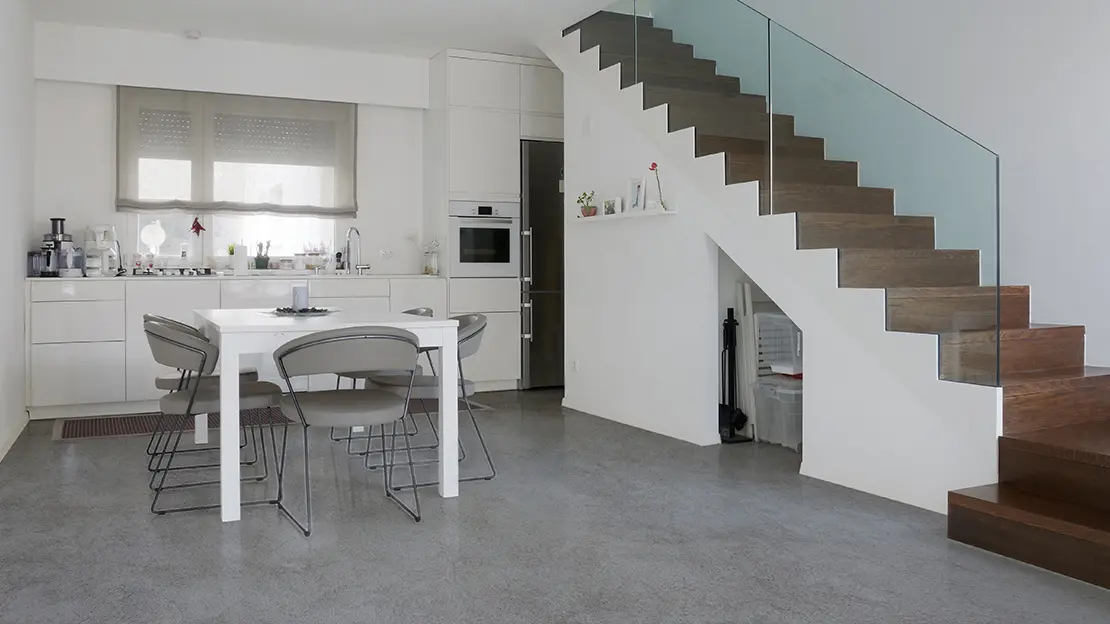
Polished concrete kitchens work perfectly and integrate with glass, metal or stone to create exquisite atmospheres. The taste for combining shapes and materials allows for customized finishes. The shiny finish of this material is combined with the variety of colors it admits. Although the most common tone is gray, we can always resort to more cheerful colors, such as red, or elegant ones, as is the case with black.
In addition, it is a material that, aesthetically, adapts very well to different materials that usually inhabit kitchens such as the wood of tables, chairs or some auxiliary furniture or the metal of some appliances or utensils. Even with ceramics or glass from plates and cups, it combines tastefully.
Polished concrete also for outdoors
Polished concrete is a versatile and durable material that has become very popular in interior and exterior decoration in recent years. One of the most common applications of polished concrete is in the creation of outdoor floors.
One of the main advantages of polished concrete for outdoor floors is its resistance to weather and external conditions. It is capable of withstanding constant exposure to the sun, rain, and other weather elements without suffering significant damage. In addition, it is resistant to wear, making it ideal for spaces that experience a large amount of pedestrian traffic.
Polished concrete is also very easy to maintain. It is very resistant to stains and can be easily cleaned with a damp mop or a vacuum cleaner. In addition, it does not require any special sealer, which makes it very convenient for homeowners who want to keep their outdoor floor in excellent condition.
Another advantage of polished concrete is its customization ability. Homeowners can choose from a wide variety of finishes, including gloss, opacity, and texture. In addition, pigments and other materials can be added to the concrete to create a unique and personalized appearance that suits any decorating style.
When installing a polished concrete floor outdoors, it is important that the job is done by an experienced and qualified professional. The installation process of polished concrete can be complicated and requires a high level of skill and experience. In addition, it is important that the contractor uses the appropriate materials and tools to ensure a quality result.
It is important to keep in mind that, despite its durability, polished concrete can suffer damage if not properly maintained. It is important to avoid the use of abrasive cleaners or strong chemicals that could damage the finish of the concrete. In addition, heavy or sharp objects that could scratch or crack the surface of the floor should be avoided.
Differences between polished cement and microcement: their similarity is only visual
It is relatively easy to confuse polished cement and microcement finishes, as they can appear identical at first glance. The main difference between both coatings lies in the structural weight of the two materials. The thickness of the microcement is just 3 millimeters, while the polished cement has a minimum of 5 centimeters.
The microcement, unlike polished concrete, it does not require expansion joints and results in continuous surfaces that enhance the brightness of any space. In addition, the application of microcement is carried out without the need to use machinery or heavy tools.
The polished cement requires a polishing machine after its application, which makes its application difficult in spaces located on high floors. The microcement is applied on the existing surface without the need to remove the existing pavement.
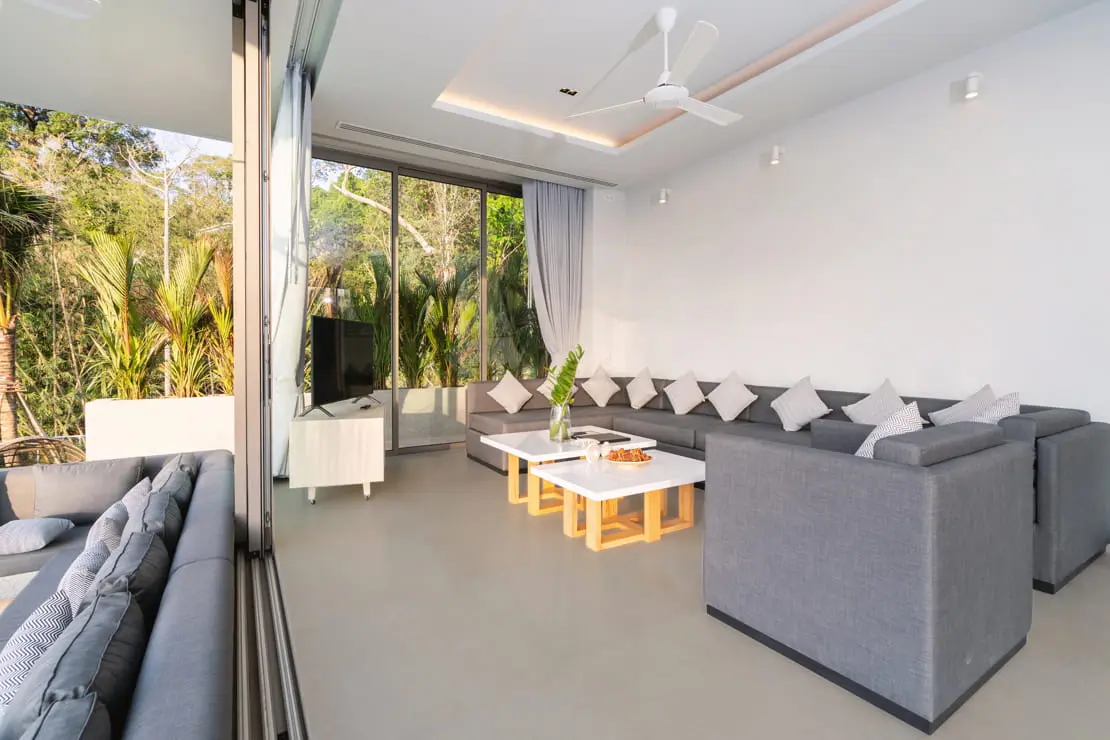
In addition to not generating debris, microcement offers greater versatility. Its application is not limited to floors, as it is a material made to cover vertical and horizontal surfaces both in interior and exterior spaces. It can be applied on floors, walls, furniture, stairs, bathrooms, and kitchens.
The decorative possibilities of microcement are endless and it is a continuous coating that adapts to any decorative style, as it provides a uniform and durable tone. Polished cement tends to crack over time. Thanks to the resins and the sealing process, microcement offers an aesthetic and resistant result over time.
If the time has come to transform the floors of your home or business, polished concrete and microcement are two good allies on the path to exquisiteness. Now, knowing the differences and similarities between the two, all that remains is to choose one of the two materials to achieve an original surface that helps you create a unique atmosphere.
Polished concrete: cleaning and maintenance
Polished concrete is an excellent option for both indoor and outdoor floors, but its maintenance and cleaning are essential to maintain its appearance and durability over time. In this article, we will talk about the guidelines you should follow to properly clean and maintain polished concrete floors in indoor and outdoor environments.
Cleaning of polished concrete floors indoors
Firstly, it's important to note that the cleaning of polished concrete should be done regularly to avoid the accumulation of dust and dirt that can affect its natural shine.
It is recommended to sweep or vacuum the floor daily, and for deep cleaning, use a neutral pH cleaner and a damp cloth. Avoid the use of abrasive or acidic products, as they can damage the surface of the polished concrete.
Also, if you spill liquids on the floor, clean them up immediately to prevent them from drying and causing permanent stains. In case of persistent stains, use a specific cleaner for polished cement and follow the manufacturer's instructions for its correct application.
Maintenance of polished concrete floors indoors
Polished concrete indoors also requires regular maintenance to extend its lifespan and maintain its appearance. To avoid scratches and marks, use mats or rugs in high traffic areas and do not drag heavy furniture across the floor.
In addition, it is important to seal the polished cement with a specific sealer layer every 1 or 2 years, depending on the use and traffic of the area.
Cleaning of polished concrete floors outdoors
In outdoor polished concrete floors, cleaning is even more important due to exposure to elements such as rain, sun, and wind.
It is advisable to sweep or clean the floor with pressurized water weekly to prevent the accumulation of dirt and prevent the growth of moss or algae. If necessary, use a specific cleaner for polished cement and follow the manufacturer's instructions for its correct application.
Maintenance of polished concrete floors outdoors
To keep polished concrete floors outdoors in optimal conditions, it is important to apply a specific outdoor sealer every 2 or 3 years. This will help protect the polished concrete from the elements and extend its lifespan.
Also, make sure the drainage of the area is working properly to avoid water accumulation that can damage the surface of the polished concrete.
How much does polished concrete installation cost?
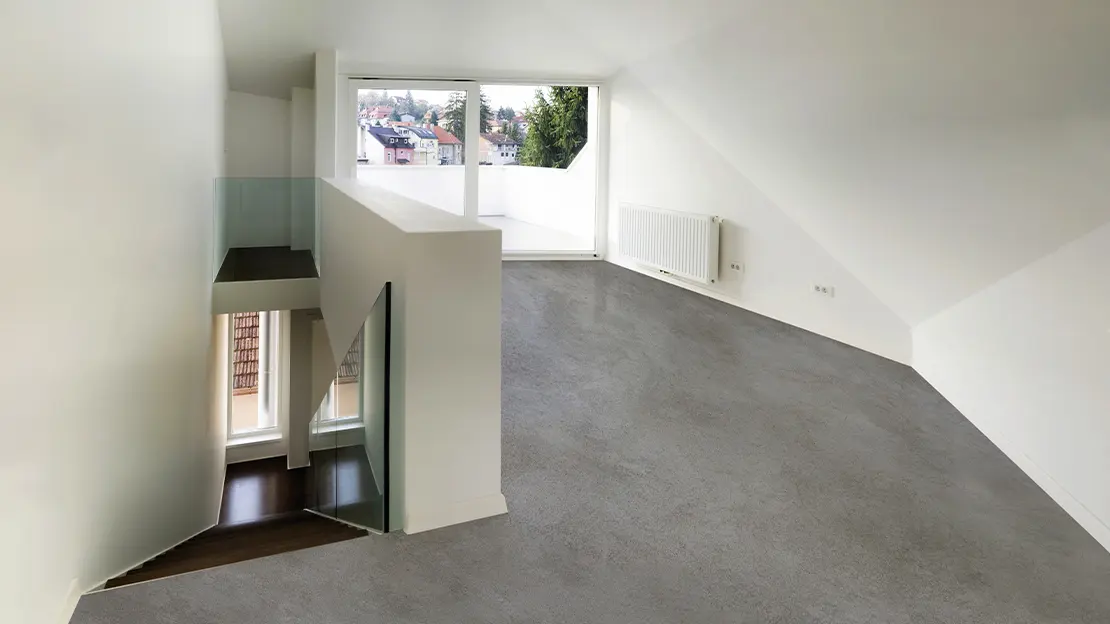
The price of installing polished concrete on a floor can vary depending on several factors. One of the main factors affecting the price is the size of the area to be covered. The larger the area, the higher the total cost of the installation. It is also important to note that the complexity of the installation, such as the need to level the floor beforehand, can also increase the cost.
Another factor to consider is the type of cement used. Polished cement can be of different qualities and prices, and some may require an additional preparation process before installation, which can also affect the total price.
Labor is also an important factor in the total cost of polished concrete installation. The installation process is labor-intensive and requires the expertise and skill of trained professionals. Labor costs can vary depending on the geographical region and the availability of contractors trained in the installation of polished concrete.
In addition to the installation cost, it is also important to consider the long-term maintenance cost of polished concrete flooring. Although it is a durable material, it is important to note that polished concrete may require regular maintenance to maintain its appearance and durability. This may include the application of sealers and polishers, which can increase the cost in the long term.
In general, the average price for the installation of polished concrete on a floor can range between 50 and 100 euros per square meter, depending on the factors mentioned above. It is important to note that the exact price can vary based on geographical location and other specific factors of the project. Therefore, it is advisable to obtain detailed quotes from several specialists before making a final decision.